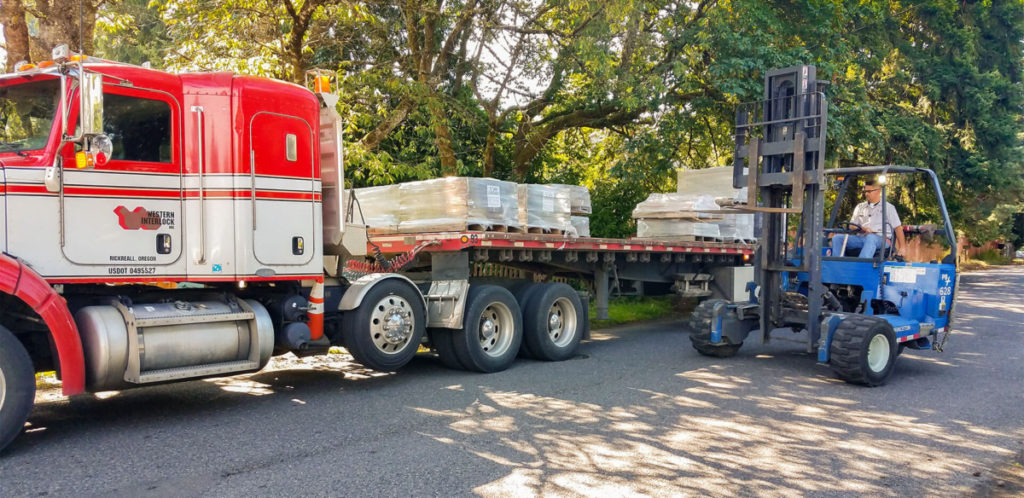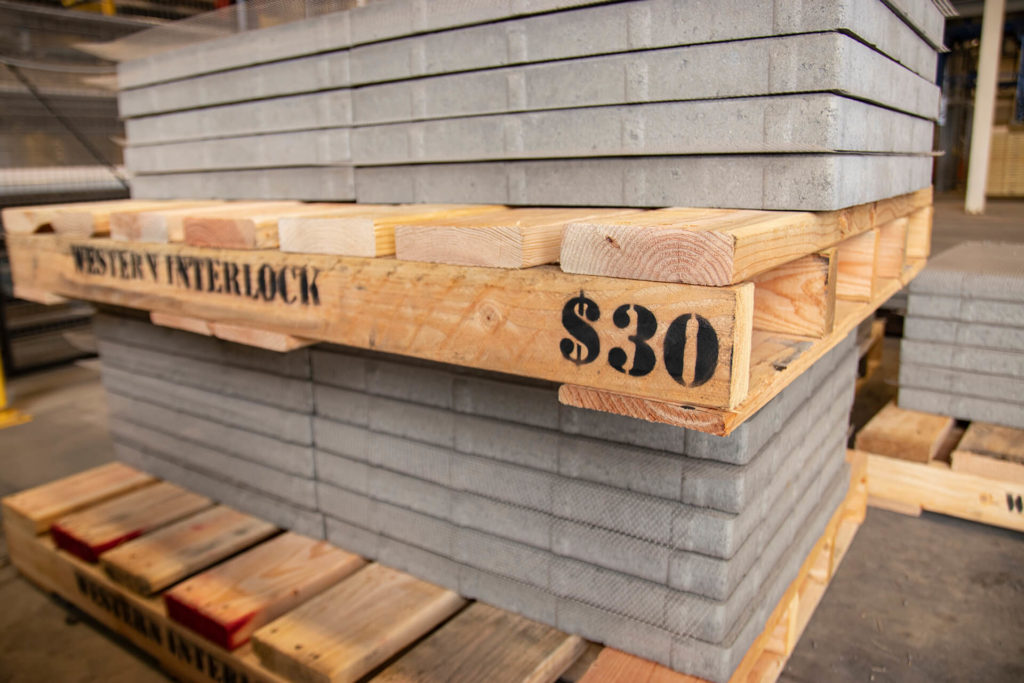Get our FREE Project Planning Guide
"*" indicates required fields
It’s likely that you already have a good idea of the kind of the project scope, including which paving stones or retaining wall blocks you want to use. If you’re still seeking answers to those questions, feel free to visit our manufacturing facility and browse our extensive display in Rickreall, OR, visit our distribution facility in Olympia, WA, or call our on-call hardscape experts at 503-623-9084.
That said, Here are authentic and honest answers to the most common questions people ask before buying hardscape from Western Interlock.
- How do I know how many paving stones I need?
- How much should I expect to pay?
- How much does a pallet of stones weigh?
- Do you deliver? If so, how?
- If I have extra stones, can I return them?
- Do I have to return the pallets?
- How much sand and gravel do I need?
- Where can I get gravel and sand?
- What do I do with extra dirt, sand, and gravel?
- How do I create a random layout?
I hope that after reading our answers, you’ll feel confident that you’re ready to start.
Note: If you’re interested in tackling installing hardscape by yourself, check out our DIY hardscape installation tips, tricks, and step-by-step tutorials at DIYwithWI.com
1. How do I know many paving stones I need?
Great question. The answer lies in the scope of your project. We’ve found that when it comes to planning a hardscape purchase, the smartest way is to start with design and then dive into the details. Here’s a simple three-step process.
First, determine the square footage of your project. Go on-site at your project location, measure out your area, and draw a simple blueprint of your project. It doesn’t have to be fancy or official, it has to be accurate, so we can help you make a purchasing decision.
Second, choose the paving stones or retaining wall blocks that you’ll want to use. Once you’ve got that clear, It’s easiest to select the type (Alpine Stone, Camino Stone, LaPietra, LaLastra) and then choose the color (Charcoal, Desert Tan, Pewter, etc.,) or blend (Jamestown Blend, Columbia Blend, Olympia Blend, etc.,).
Third, resolve any patterns or borders you want to lay. It could be a simple random pattern or, if you are design inclined, it could be complex. The reason this is important is that the pattern determines any other stones you’ll need to buy to implement your design vision.
Once you’ve done these steps, it’s time to do a simple math equation to know how many stones you’ll need to purchase. Estimate the square feet of your area by multiplying the length by the width of your hardscape area. Then, call our hardscape experts at 503-623-9084 and we’ll help you dial in the rest of the math so you know the exact number of stones you’ll need.
2. How much should I expect to pay?
In general, paving stones cost an average of $3.53/per square foot, with some being more and some being less, depending on color and design. Retaining wall blocks cost an average of $15.51/per face square foot, with some being more and some being less, depending on block and color.

To get the total price for your entire hardscape project, you’ll need to multiply the pricing per stone (or block) by the number of stones you’ll need. Call our hardscape experts at 503-623-9084 to get pricing per stone or block, then add the numbers together and you’ll know exactly how much you should expect to pay.
What if Western Interlock pavers are more expensive? Be sure you’re comparing apples to apples. While we hesitate to comment directly on any of our competition, check out the video below to see a comparison between our pavers and some generic pavers from a big box store.
3. How much does a pallet of stones weigh?
A pallet of stones weighs about 3,000 pounds, the same as a Ford Focus. That’s a ton and a half of concrete bricks! Each pallet contains about 100 square feet of stones. If you want to know approximately how many pallets you’ll need for your project, divide your total square footage by 100.
4. Do you deliver? If so, how does it work?
Absolutely. Unless you’re installing a fire pit kit or building a stone grill surround, you’ll likely need the assistance of a 48-foot flatbed semi-truck with a carry-on forklift. Before we deliver, we’ll always verify that we can access the drop site. We’ll need enough room to turn a large truck around along with 15 feet vertical clearance above any trees or carports.

If you’d like to pick up your load yourself, you can. Just know that you’ll need a minimum of a half-ton pickup truck to tow a few pallets on a small trailer or a three-quarter-ton pickup truck to haul one pallet in the bed.
5. If I have extra stones, can I return them?
There’s nothing worse than being stuck with something you don’t need. That’s why we’ve always let our customers return extra stones for a full refund. It’s industry standard to charge a per-stone restocking fee for any returned items, but since it’s challenging to deliver the precise amount of stones for a project, we don’t charge any extra fees.
6. Do I have to return the pallets?
No, you don’t have to return the pallets. However, just like glass milk jars, we charge a $20–30 deposit for each pallet delivered.

Any time after delivery, you can bring your pallets back for a full refund. If you have a few pallets of extra stones, you can deliver them just as they came for a full refund on the stones and the pallets. Customers will often rush individual pallets back during their project, but there’s no rush. You can return the pallets in bulk after the project is complete without accruing any interest or late fees.
7. How much sand & gravel do I need?
You’ll need both sand and gravel for your hardscape project. For gravel, you’ll need 4–6” of ¾ minus crushed gravel.

One yard of gravel covers approximately 80 square feet. For the sand, you’ll need 1” of concrete sand. One yard of sand includes about 200 square feet.
8. Where can I get gravel and sand?
The most convenient way to supply gravel and sand is from a landscape supply company or rock quarry near your home. However, we sell sand and gravel as well and would be happy to deliver it along with your paving stones so all your materials arrive at the same time. Talk to your sales representative and they’ll make sure to add aggregate materials to your order.

If you don’t mind working for your material, you can find cheap (or free) gravel or sand on Craiglist or other classifieds from other DIYers who have extra after their project is complete.
9. What do I do with extra dirt, sand, and gravel?
Often, there will be extra dirt, sand, or gravel that you no longer want or need when the project is complete. There are a few smart ways to dispose of the material.

If you have a large amount of material, it might make sense to rent a roll-off dumpster. You’ll have to load it up yourself, but this option offers guaranteed, scheduled disposal of your rocks or gravel. If you have a small amount of material, you can load up a pickup bed or small trailer and dump the rocks yourself at a local landfill or transfer station.
If you want to get creative, you can post an ad on Craiglist. Often, landscapers, contractors, and other DIYers are looking to repurpose your unwanted materials for their projects. Remember, one person’s trash is another person’s treasure.
Lastly, if you want to get the extra material out of your sight, you can hire a junk removal company. Before you book, make sure to confirm that they take heavy debris, such as rocks and concrete.
10. How do I create a random layout?
We understand that you want your hardscape to look beautiful. You’re investing a lot of time and money into your project, so it should turn out as good, or better than you expected. The truth is you create a random layout by placing stones randomly.

The good news is that stones are loaded on each pallet randomly, so if you lay the stones as you pick them off the pallet, you’ll end up with a great-looking random pattern.
If you want more information on this, take a look at How to Lay a Perfect Paver Pattern, our step-by-step tutorial on how to lay a variety of different patterns. In this tutorial, we cover random layouts, how they work, and what you need to know.
Have another question?
If you have any questions that we didn’t answer in this article, take a look at our Frequently Asked Questions page or call our on-call hardscape experts at 503-623-9084.
Get our FREE Project Planning Guide
Tell us where to send it and we’ll email the backyard planning guide to you right away!
"*" indicates required fields






